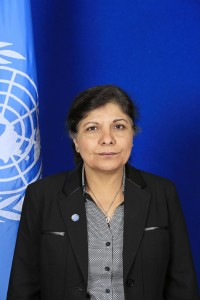New Momentum on Climate Must Generate Action in Asia and the Pacific: Op-Ed by Dr. Shamshad Akhtar
Op-Ed by Dr. Shamshad Akhtar, Under-Secretary-General of the United Nations

The landmark Climate Summit convened by the United Nations Secretary-General last week in New York was unprecedented in terms of the participation of leaders,the private sector and a range of other stakeholders. The level and scale of enthusiasm it generated augurs well for global climate action and for future generations.This new momentum must now translate into real action in Asia and the Pacific.
Leaders at the Summit offered commitments that will feed into the UN Climate Change Conference to be held in Paris next year. Some categorically committed to cut emissions, and called for greater action to limit the rise in global temperaturesto less than 2 degrees Celsius. Initial commitments at the Summitfor the capitalization of the Green Climate Fund amounted to more than $2.3 billion, with new multi-stakeholder partnerships registered for low carbon and climate resilient development finance, amounting to almost $200 billion. It’s a good start, but much more is needed. To support the public commitments, calls have been made for greater engagement byfinancial institutions, the insurance sector and institutional investors,who hold enormous global and regional savings which can service the risk and long-term capital requirements of climate adaptation and mitigation projects.
The Summit also overwhelmingly supported carbon pricing as a tool to reduce emissions and to improve sustainability,as well as economic growth prospects. Equally hearteningwere the cross-sectoral, multi-stakeholder coalitions which emerged, from the Global Agricultural Alliance to secure food for rapidly growing populations, to the dozens of Governments, businesses, civil society groups and indigenous peoples who pledged to end deforestation by 2030.
The clearest and most pertinent message from the Summitwas thatclimate change is a global threat and must be tackled by global partnerships for a more sustainable future.
The UN Secretary General reminded us that “the human, environmental and financial cost of climate change is fast becoming unbearable.” President Obama emphasizedthat thecost of inaction is far greater than the cost of action.No region of the world knows this better than Asia and the Pacific, where there is a compelling case for urgent climate action.
Between 1980 and 2009 the people of Asia and the Pacific shouldered the burden of 85 per cent of global deaths and 38 per cent of global economic losses due to natural disasters. Just weeks ago, heavy monsoon rains and floods across Pakistan caused more than 300 deaths and impacted more than 1.8 million people. Typhoon Haiyan caused the death of more than 8000 people in the central Philippines last year, with an estimated $15 billion in damages.We are witnessing some of the worstnatural disasters in recorded history, and they are destroying the lives and livelihoods of millions across our region.
Resource and carbon-intensive economies are also economically vulnerable. The Asia-Pacific region uses three times more resources to produce one unit of GDP than the rest of the world. We are not only the region most vulnerable to climate-related disasters, but also to resource-price volatility.As resource costs rise, the economic impacts are most severe onthe poorest and vulnerable in our region.More than 42 million people in Asia and the Pacific were pushed back into poverty due to rising energy and food prices in 2011 alone.
Innovative climate action to improve our region’s energy and resource efficiency not only reduces emissions, butwillalso drivesustainable economic growth in the face of rising resource prices, generating jobs and reducingpoverty while increasing long-term resilience to natural disasters and the impacts of rising resource costs.
Turning resource constraints and the climate crisis into opportunities for economic growth and poverty reduction, Asia-Pacific countries have adopted pioneering strategies to promotegreen growthand environmentally sustainable approaches, while strengthening regional integration and cooperation to address risks and vulnerabilities, which include disasters, climate change and resource constraints, alongside improving trade, finance and investments, as well as physical infrastructure connectivity.
At the Summit, China affirmed its aim to reduce carbon emissions per unit of GDP by 45% compared to 2005. Fiji spoke of their green growth strategy,already in place, and ambitions to generate all electricity from renewable resources by 2030.Malaysia andIndonesia are reforming fossil fuel subsidies to encourage a shift to cleaner energy. Mongolia plans to reach 20-25% of total energy production from renewables by 2020. These are but some examples of the already strong regional climate actions taking place.
But change is not happening fast enough. We need to massively scale up these actions,not only to match the magnitude and urgency of climate impacts, but also to harness the economic growth and opportunities whichclimate action entails.
The UN Economic and Social Commission for Asia and the Pacific will continue to urge leaders in the region to seize the opportunity to intensify national climate actions and commitments, and to work even more closely together to make our vision of the sustainable, prosperous and resilient future we want a reality.Moving the climate frontier from negotiations and commitmentto realaction is not only urgent but also opens a new window of sustainable development opportunity for all in Asia and the Pacific.
The author is an Under-Secretary-General of the United Nations and Executive Secretary of the Economic and Social Commission for Asia and the Pacific (ESCAP). She is also the UN’s Sherpa for the G20 and previously served as Governor of the Central Bank of Pakistan and Vice President of the MENA Region of the World Bank.
Posted: September 30, 2014
